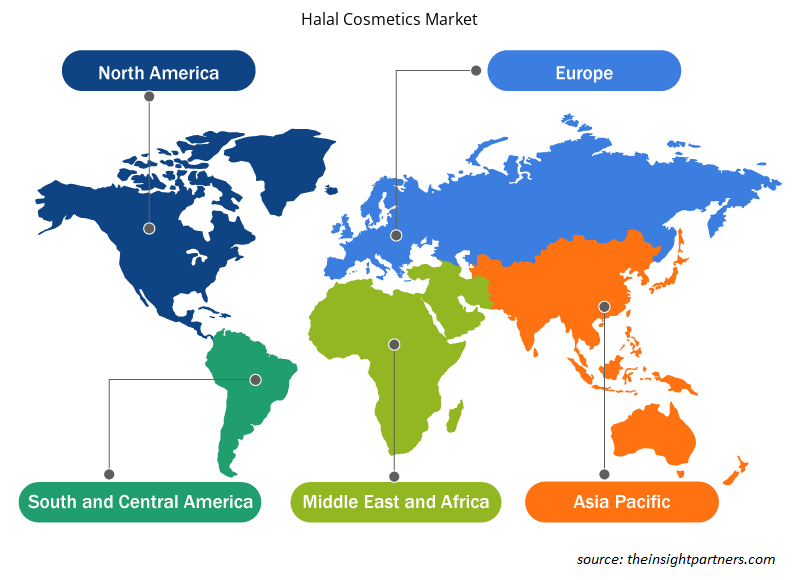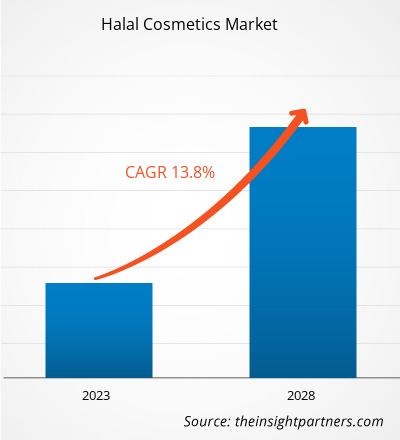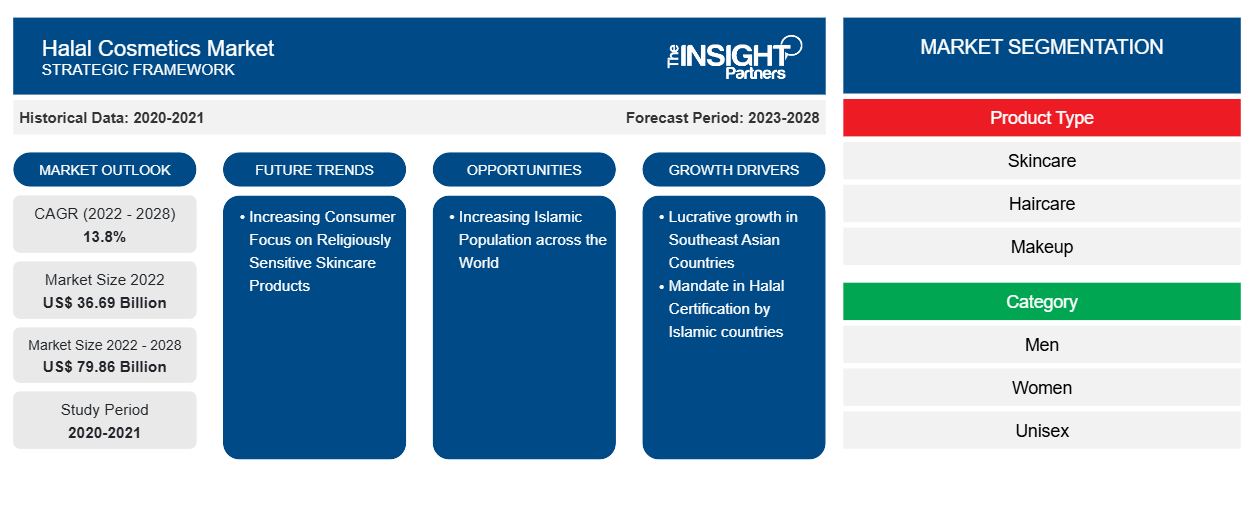[Forschungsbericht] Der Markt für Halal-Kosmetik soll von 36.686,54 Millionen US-Dollar im Jahr 2022 auf 79.861,73 Millionen US-Dollar im Jahr 2028 wachsen; von 2022 bis 2028 wird mit einer durchschnittlichen jährlichen Wachstumsrate von 13,8 % gerechnet.
Markteinblicke und Analystenansichten:
Halal-Kosmetikprodukte sind Kosmetikprodukte, die den islamischen Standards entsprechen, d. h. Kosmetikprodukte ohne von Schweinen stammende oder andere verbotene Inhaltsstoffe. Halal-Kosmetikprodukte sind außerdem wudu-freundlich (wasserdurchlässig), wie es die islamischen Standards verlangen. Die Halal-Kosmetikprodukte werden mit nach islamischem Recht „zulässigen“ Inhaltsstoffen bezogen und hergestellt. Halal-Kosmetik enthält keinen Alkohol oder Inhaltsstoffe tierischen Ursprungs, die für Muslime verboten sind.
Wachstumstreiber und Herausforderungen:
Halal-Kosmetik erfreut sich unter der muslimischen Bevölkerung großer Beliebtheit, da die Nachfrage nach Körperpflegeprodukten und trendigen Kosmetik- und Schönheitsprodukten, die religiösen Loyalitäten entsprechen, zunimmt. Das Wachstum des globalen Marktes für Halal-Kosmetik ist auf die steigende Kaufkraft der wachsenden muslimischen Bevölkerung weltweit zurückzuführen. Der Wunsch junger muslimischer Frauen, ihr Interesse an Mode und Make-up mit islamischen Loyalitäten zu verbinden, in Ländern wie Saudi-Arabien, Malaysia, Iran, den Vereinigten Arabischen Emiraten und Indonesien sowie Verbraucher, die sich gleichermaßen für Mode- und Make-up-Trends interessieren, haben den Konsum von Halal-Kosmetik angekurbelt, was der globalen Halal-Kosmetikindustrie Auftrieb verleihen wird. Darüber hinaus erweitern einige vegane Sorten auch die Marktchancen für die nicht-muslimische Bevölkerung. Beispielsweise bieten das indische Unternehmen Eco Trail und das in Großbritannien ansässige Unternehmen PHB Ethical Beauty Produkte an, die nicht nur Halal-zertifiziert, sondern auch frei von Tierversuchen und Schadstoffen sind. Diesem Trend folgen führende globale Marken wie The Body Shop und Forest Essentials, was wiederum die Marktexpansion unterstützt. Allerdings sind die Preise für Halal-zertifizierte Kosmetika viel höher als für herkömmliche Kosmetikprodukte, was das Marktwachstum bremsen kann.
Passen Sie diesen Bericht Ihren Anforderungen an
Sie erhalten kostenlos individuelle Anpassungen an jedem Bericht, einschließlich Teilen dieses Berichts oder einer Analyse auf Länderebene, eines Excel-Datenpakets sowie tolle Angebote und Rabatte für Start-ups und Universitäten.
- Holen Sie sich die wichtigsten Markttrends aus diesem Bericht.Dieses KOSTENLOSE Beispiel umfasst eine Datenanalyse von Markttrends bis hin zu Schätzungen und Prognosen.
Berichtssegmentierung und -umfang:
Der „globale Markt für Halal-Kosmetik“ ist nach Produkttyp, Kategorie, Vertriebskanal und Geografie segmentiert. Basierend auf dem Produkttyp ist der Markt für Halal-Kosmetik in Hautpflege, Haarpflege, Make-up und andere unterteilt. Basierend auf der Kategorie ist der Markt in Männer, Frauen und Unisex unterteilt. Basierend auf dem Vertriebskanal ist der Markt für Halal-Kosmetik in Supermärkte und Hypermärkte, Fachgeschäfte, Online-Einzelhandel und andere unterteilt. Basierend auf der Geografie ist der Markt für Halal-Kosmetik in Nordamerika (USA, Kanada und Mexiko), Europa (Deutschland, Frankreich, Italien, Großbritannien, Russland und Rest von Europa), Asien-Pazifik (Australien, China, Japan, Indien, Südkorea und Rest von Asien-Pazifik), Naher Osten und Afrika (Südafrika, Saudi-Arabien, Vereinigte Arabische Emirate und Rest von Nahem Osten und Afrika) und Süd- und Mittelamerika (Brasilien, Argentinien und Rest von Süd- und Mittelamerika) unterteilt.haircare, makeup, and others. Based on category, the market is classified into men, women, and unisex. Based on distribution channel, the halal cosmetics market is segmented into supermarkets and hypermarkets, specialty stores, online retail, and others. The halal cosmetics market based on geography is segmented into North America (US, Canada, and Mexico), Europe (Germany, France, Italy, UK, Russia, and Rest of Europe), Asia Pacific (Australia, China, Japan, India, South Korea, and Rest of Asia Pacific), Middle East & Africa (South Africa, Saudi Arabia, UAE, and Rest of Middle East & Africa), and South & Central America (Brazil, Argentina, and Rest of South & Central America)
Segmentanalyse: Analysis:
Basierend auf dem Produkttyp ist der Markt für Halal-Kosmetik in Hautpflege, Haarpflege, Make-up und Sonstiges unterteilt. Das Segment Hautpflege hatte den größten Anteil am Markt für Halal-Kosmetik und wird im Prognosezeitraum voraussichtlich ein deutliches Wachstum verzeichnen. Die meisten Kosmetika enthalten Inhaltsstoffe, die Hautreizungen verursachen und sich langfristig auf die Gesundheit auswirken können. Daher hat sich Halal-Kosmetik als alternative und wirksame Lösung für Verbraucher erwiesen. Ein steigendes verfügbares Einkommen in Verbindung mit der Übernahme eines modernen Lebensstils wird als der wichtigste Faktor angesehen, der den Markt für Halal-Kosmetik weltweit ankurbeln könnte.
Regionale Analyse:
Geografisch ist der Markt für Halal-Kosmetik in fünf Hauptregionen unterteilt: Nordamerika, Europa, Asien-Pazifik, Süd- und Mittelamerika sowie Naher Osten und Afrika. Der globale Markt für Halal-Kosmetik wurde vom Asien-Pazifik-Raum dominiert, der im Jahr 2022 14.838,48 Millionen US-Dollar ausmachte. Der Nahe Osten und Afrika sind ein zweitwichtigster Marktteilnehmer mit einem Anteil von über 20 % am Weltmarkt. Für Europa wird im Prognosezeitraum ein beträchtliches Wachstum mit einer durchschnittlichen jährlichen Wachstumsrate von über 13,9 % erwartet. gilt aufgrund des gestiegenen Bewusstseins für tierversuchsfreie Produkte und der gestiegenen Bevölkerung als einer der wichtigsten Märkte für Halal-Kosmetik. Der Anstieg ausländischer Direktinvestitionen führt auch zu regionalem Wirtschaftswachstum. Darüber hinaus gibt es im Nahen Osten und in Afrika eine große muslimische Bevölkerung, was Halal-Kosmetikprodukten lukrative Wachstumschancen bietet. Solche Faktoren haben es globalen Marken und Online-Händlern ermöglicht, ihr Angebot zu erweitern, um die Nachfrage zu decken. Aufgrund der Nachfrage nach Halal-zertifizierten Produkten in der Region hat der saudi-arabische PIF (Public Investment Fund) im Oktober 2022 seine neue Halal Products Development Company gegründet. Ziel des Unternehmens ist es, Körperpflege- und Kosmetikprodukte vor Ort in Saudi-Arabien herzustellen und Halal-zertifizierte Produkte weltweit zu exportieren.
Branchenentwicklungen und zukünftige Chancen:
Nachfolgend sind verschiedene Initiativen der wichtigsten Akteure auf dem Markt für Halal-Kosmetik aufgeführt:
- Im November 2022 ging Iba Cosmetics, ein Hersteller von Halal-Kosmetik, eine Partnerschaft mit dem in Singapur ansässigen Unternehmen Believe ein. Believe hat 10 Millionen US-Dollar investiert, um mit Iba Cosmetics zusammenzuarbeiten und seinen Einzelhandelsmarkt in operativen Ländern wie dem Nahen Osten, Europa und Südasien zu vertreiben und zu erweitern.Iba Cosmetics, a Halal cosmetics manufacturer, partnered with Believe company based in Singapore. Believe company has invested US$ 10 million to partner with Iba Cosmetics to distribute and expand their retail market space across operating countries such as Middle Eastern and European and South Asia countries.
- Im November 2022 ging Iba Cosmetics eine Partnerschaft mit dem in Singapur ansässigen Unternehmen Believe ein. Das Unternehmen Believe hat 10 Millionen USD investiert, um mit Iba Cosmetics zusammenzuarbeiten und seinen Einzelhandelsmarkt in operativen Ländern wie dem Nahen Osten, Europa und Südasien zu vertreiben und zu erweitern.Iba Cosmetics partnered with Believe company based in Singapore. Believe company has invested USD 10 million to partner with Iba Cosmetics to distribute and expand their retail market space across operating countries such as Middle Eastern and European and South Asia countries.
- Im April 2022 brachte Inika Organic seine neue Kosmetikkollektion Pure with Purpose auf den Markt. Die Produktpalette der Gruppe umfasst Lash & Brow Serum, Hydrating Toning Mist, Eyeshadow Quads, Brow Palette und mehr. Diese Produkte sollen 100 % natürlich, vegan-zertifiziert, halal-zertifiziert und frei von Tierversuchen sein.Inika Organic launched its new cosmetics collection, Pure with Purpose. The range of products included in the group is Lash & Brow Serum, Hydrating Toning Mist, Eyeshadow Quads, Brow Palette, and more. These products are claimed to be 100% natural, vegan-certified, halal-certified, and cruelty-free.
- Im August 2021 arbeitete Kao Corporation, ein japanischer Hersteller von Halal-zertifizierter Kosmetik, mit Lion Corporation zusammen, um recycelbare Verpackungen zu entwickeln und den Plastik-Fußabdruck zu minimieren.Kao Corporation, a Japanese manufacturer of halal-certified cosmetics, collaborated with lion corporation to develop recyclable packaging and minimize the plastic footprint.
Auswirkungen von Covid-19:
Die COVID-19-Pandemie betraf fast alle Branchen in verschiedenen Ländern. Lockdowns, Reisebeschränkungen und Betriebsschließungen in Nordamerika, Europa, Asien-Pazifik (APAC), Süd- und Mittelamerika (SAM) sowie dem Nahen Osten und Afrika (MEA) behinderten das Wachstum mehrerer Branchen, darunter auch der Konsumgüterindustrie. Die Schließung von Produktionseinheiten störte globale Lieferketten, Fertigungsaktivitäten, Lieferpläne sowie den Verkauf lebensnotwendiger und nicht lebensnotwendiger Produkte. Verschiedene Unternehmen erlebten im Jahr 2020 Verzögerungen bei Produktlieferungen und einen Einbruch der Verkäufe ihrer Produkte. Verschiedene Hersteller von Halal-Kosmetika mussten ihre Betriebe vorübergehend schließen oder ihre Produktionskapazitäten einschränken, was sich negativ auf das Wachstum des Halal-Kosmetikmarktes auswirkte. Außerdem waren die Hersteller in der Anfangsphase der Krise stark von den vorhandenen Lagerbeständen abhängig. Aufgrund der durch die Pandemie verursachten Wirtschaftsrezession wurden die Verbraucher bei Kaufentscheidungen vorsichtiger und selektiver. Die Verbraucher reduzierten nicht lebensnotwendige Einkäufe aufgrund niedrigerer Einkommen und unsicherer Verdienstaussichten erheblich, insbesondere in Entwicklungsregionen. Bis Ende 2021 waren jedoch viele Länder vollständig geimpft und die Regierungen kündigten Lockerungen bestimmter Vorschriften an, darunter Ausgangssperren und Reiseverbote. Nach der Pandemie fragen Verbraucher zunehmend nach Haut- und Haarpflegeprodukten, da es nach der COVID-19-Pandemie einen wachsenden Trend zur Selbstpflege gibt. Das Wachstum des Online-Einzelhandels während der Pandemie hat auch den Herstellern von Halal-Kosmetik Wachstumschancen geboten. Darüber hinaus hat die Lockerung der Handelsbeschränkungen zum Import und Export von Halal-Kosmetik geführt, was sich positiv auf den Markt auswirkte.
Regionale Einblicke in den Halal-Kosmetikmarkt
Die regionalen Trends und Faktoren, die den Markt für Halal-Kosmetik im Prognosezeitraum beeinflussen, wurden von den Analysten von Insight Partners ausführlich erläutert. In diesem Abschnitt werden auch die Marktsegmente und die Geografie des Halal-Kosmetikmarkts in Nordamerika, Europa, im asiatisch-pazifischen Raum, im Nahen Osten und Afrika sowie in Süd- und Mittelamerika erörtert.

- Holen Sie sich die regionalen Daten für den Halal-Kosmetikmarkt
Umfang des Marktberichts über Halal-Kosmetik
| Berichtsattribut | Details |
|---|---|
| Marktgröße im Jahr 2022 | 36,69 Milliarden US-Dollar |
| Marktgröße bis 2028 | 79,86 Milliarden US-Dollar |
| Globale CAGR (2022 - 2028) | 13,8 % |
| Historische Daten | 2020-2021 |
| Prognosezeitraum | 2023–2028 |
| Abgedeckte Segmente | Nach Produkttyp
|
| Abgedeckte Regionen und Länder | Nordamerika
|
| Marktführer und wichtige Unternehmensprofile |
|
Marktteilnehmerdichte: Der Einfluss auf die Geschäftsdynamik
Der Markt für Halal-Kosmetik wächst rasant, angetrieben durch die steigende Nachfrage der Endverbraucher aufgrund von Faktoren wie sich entwickelnden Verbraucherpräferenzen, technologischen Fortschritten und einem größeren Bewusstsein für die Vorteile des Produkts. Mit steigender Nachfrage erweitern Unternehmen ihr Angebot, entwickeln Innovationen, um die Bedürfnisse der Verbraucher zu erfüllen, und nutzen neue Trends, was das Marktwachstum weiter ankurbelt.
Die Marktteilnehmerdichte bezieht sich auf die Verteilung der Firmen oder Unternehmen, die in einem bestimmten Markt oder einer bestimmten Branche tätig sind. Sie gibt an, wie viele Wettbewerber (Marktteilnehmer) in einem bestimmten Marktraum im Verhältnis zu seiner Größe oder seinem gesamten Marktwert präsent sind.
Die wichtigsten auf dem Markt für Halal-Kosmetik tätigen Unternehmen sind:
- Clara International Beauty Group
- Inglot Kosmetik
- Inika Organic Australien
- IVY Beauty Corporation
- MMA Bio Lab Sdn Bhd
Haftungsausschluss : Die oben aufgeführten Unternehmen sind nicht in einer bestimmten Reihenfolge aufgeführt.

- Überblick über die wichtigsten Akteure auf dem Halal-Kosmetikmarkt
Wettbewerbslandschaft und Schlüsselunternehmen:
Zu den führenden Akteuren auf dem globalen Markt für Halal-Kosmetik gehören unter anderem Clara International Beauty Group, Inglot Cosmetics, Inika Organic Australia, IVY Beauty Corporation, MMA Bio Lab Sdn Bhd, OnePure, LLC, PT Paragon Technology and Innovation, PHB Ethical Beauty Ltd., Sampure Minerals und IBA Cosmetics.
- Historische Analyse (2 Jahre), Basisjahr, Prognose (7 Jahre) mit CAGR
- PEST- und SWOT-Analyse
- Marktgröße Wert/Volumen – Global, Regional, Land
- Branchen- und Wettbewerbslandschaft
- Excel-Datensatz
Aktuelle Berichte
Verwandte Berichte
Erfahrungsberichte
Grund zum Kauf
- Fundierte Entscheidungsfindung
- Marktdynamik verstehen
- Wettbewerbsanalyse
- Kundeneinblicke
- Marktprognosen
- Risikominimierung
- Strategische Planung
- Investitionsbegründung
- Identifizierung neuer Märkte
- Verbesserung von Marketingstrategien
- Steigerung der Betriebseffizienz
- Anpassung an regulatorische Trends























 Kostenlose Probe anfordern für - Halal-Kosmetikmarkt
Kostenlose Probe anfordern für - Halal-Kosmetikmarkt